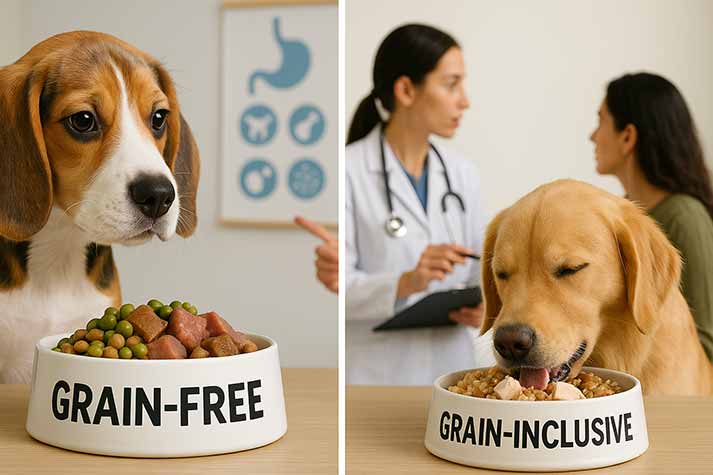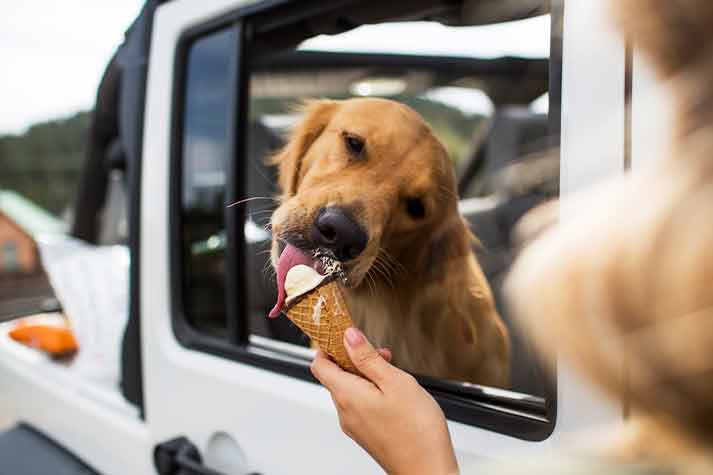
11 Jun
Grain-Free vs. Grain-Inclusive Dog Food: Making the Right Choice for Your Furry Friend
The world of pet food has come a long way in recent years. With so many options on the shelves, it can feel like picking the right food for your dog is more complicated than ever.
You want the best for your pup, but with all the talk about grain-free and grain-inclusive diets, it is easy to get confused. Don’t worry though; in this handy guide, we’ll break down what these terms really mean and how you can make the best choice for your furry companion.
Here’s How to Make the Right Choice
What Does “Grain-Free” Really Mean?
As the name suggests, grain-free dog food is made without common grains like wheat, corn, rice, or barley. Instead, these foods use other ingredients, such as lentils, peas, potatoes, or even chickpeas, to provide the carbs and fibre your dog needs. Grain-free diets are often marketed as being more “natural” or “premium,” and you might hear that they are especially good for active or working breeds that thrive on higher protein.
Remember though; just because a food is grain-free, does not automatically mean it is a better option for your pet. Sometimes, these foods swap out grains for other ingredients in higher amounts, and not all substitutes are created equal. High-quality grain-free foods will focus on real meat and nutritious veggies, but it is still important to read the label. Do not be surprised if you see a tiny bit of grain listed; after all cross-contamination or small traces can occur, but they should be minimal.
Understanding Grain-Inclusive Dog Food
Grain-inclusive dog food simply means that grains are part of the recipe. Not all grains are created equal, though. There is a big difference between nutritious grains like brown rice, barley, and oatmeal (which provide fibre and vitamins) and filler grains like corn, soy, and wheat, which are often used just to bulk up the food without adding much nutritional value.
Grains have gotten a bad reputation over the years, but the truth is, most dogs digest grains just fine. In fact, for many pups, a grain-inclusive diet can be easier on the stomach, especially if they are not very active or have sensitive tummies. The key is to make sure grains are not the main ingredient; your dog’s food should be packed with quality nutrition, not just fillers.
Sorting Fact from Fiction
It is easy to get caught up in pet food marketing, but do not let buzzwords drive your decisions. Here are a few things to remember:
- Not all grains are bad: Healthy grains can be a great source of fibre and nutrients.
- Grain allergies in dogs are rare: Most food allergies in dogs are caused by animal proteins, not grains.
- Grain-free is not always safer. Some grain-free foods use lots of peas or lentils, which have recently been linked to a heart condition called DCM (dilated cardiomyopathy) in some dogs. The research is ongoing, but it is something to be aware of, especially if your dog’s breed is already at risk for heart issues.
What Should You Look for in Dog Food?
Whether you are considering grain-free or grain-inclusive diet, quality matters most. Here’s what to keep an eye on:
- Clear protein sources: Look for foods that list specific meats, like “chicken meal” or “lamb meal,” rather than vague terms like “meat meal.”
- Minimal fillers and additives: Avoid foods loaded with artificial colours, flavors, or preservatives.
- Balanced nutrition: Make sure the food is complete and balanced for your dog’s age, size, and activity level.
The Bottom Line
There is no single “right” answer when it comes to grain-free versus grain-inclusive dog food. Each dog is different, and what works for one might not be suitable for another. The best thing you can do is pay attention to your dog’s needs, read those ingredient labels, and talk to your vet before making any big changes.
At the end of the day, your goal is simple: a happy, healthy pup with a wagging tail and plenty of energy. Whether you choose grain-free or grain-inclusive, focus on high-quality ingredients and a balanced diet tailored to your dog’s unique needs. And remember, when in doubt, your veterinarian is always there to help guide you.






AUTHOR’S BIO
Carry My Pet
Passionate pet enthusiasts and globetrotters, dedicated to easing furry friends' journeys worldwide. Penning tales of compassion at CarryMyPet, where every relocation is a tail-wagging adventure.